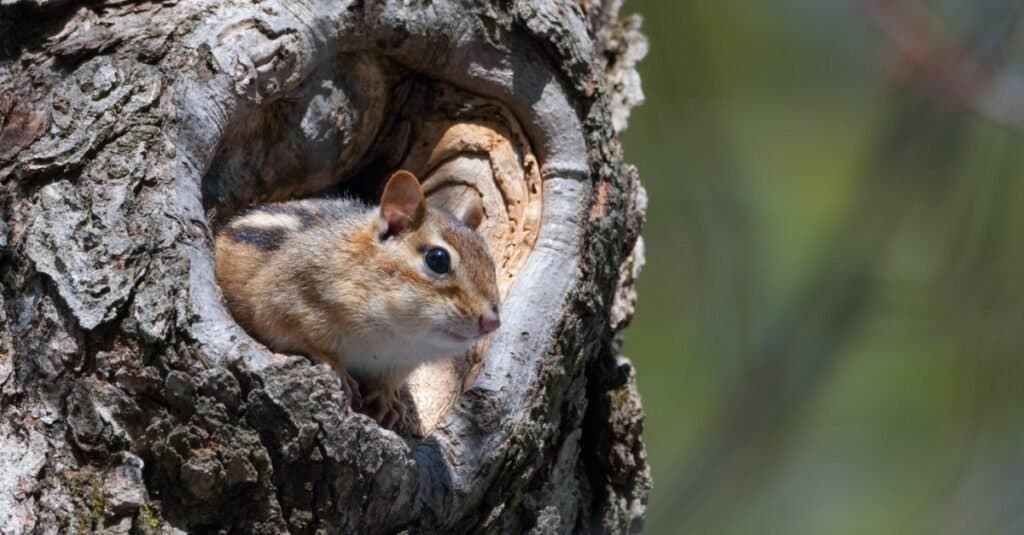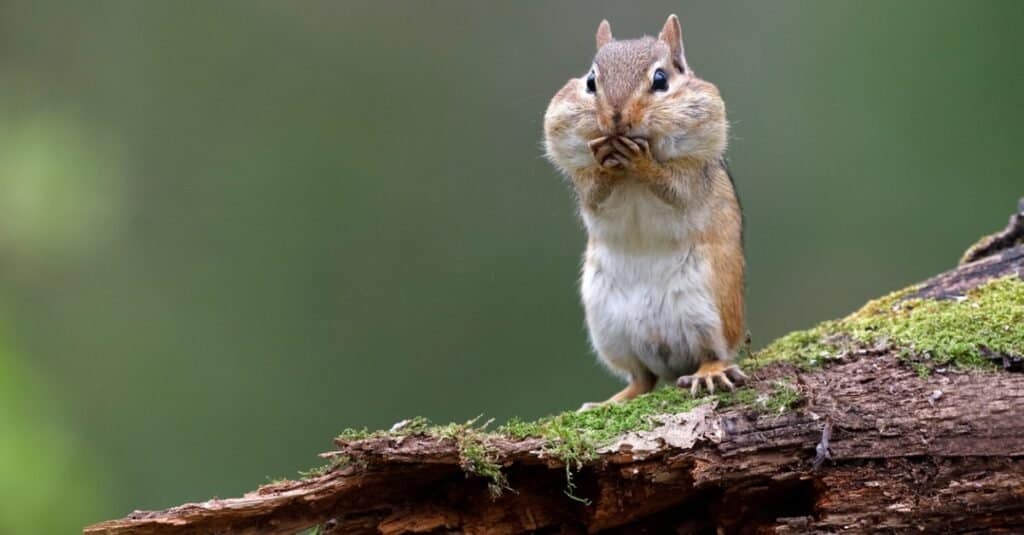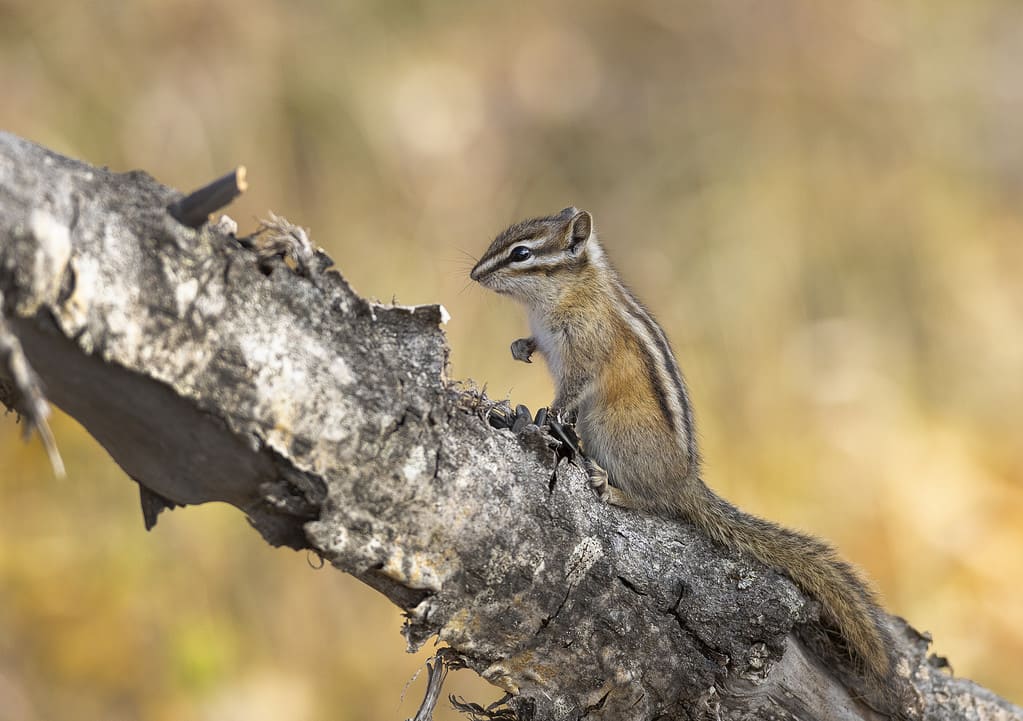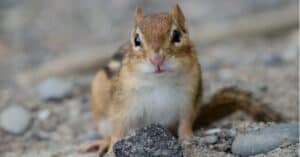The name “chipmunk” comes from an Ojibwe word that translates to “one who descends trees headlong.” This name is appropriate, as chipmunks are one of the few species that can climb down surfaces headfirst, along with other types of squirrels, sloths, weasels, raccoons, lemurs, and martens.
These cheeky squirrels are talented climbers, as their name implies. However, unlike tree squirrels, chipmunks mostly stay on the ground. Although chipmunks are in the same Sciuridae family as tree squirrels (and are adept climbers), they look elsewhere when it comes time to bed down. Let’s look at where chipmunks nest and how they construct their homes.
Chipmunk Range

The eastern chipmunk is the largest chipmunk species in North America and can weigh up to five ounces.
©iStock.com/Kyle Bedell
There are 25 species of chipmunk in the world, and only one (Asia’s Siberian chipmunk) is found outside North America. With over 20 species of chipmunk on the continent, they can be found in just about every habitat in North America ranging from forests and mountains to deserts. The two most widely distributed species are the eastern chipmunk (Tamias striatus) and the least chipmunk (Tamias minimus).
Eastern Chipmunk
Eastern chipmunks can be found almost anywhere in the eastern United States, except for some places in the Carolinas and Florida. Their range also extends up into southeastern Canada. Chipmunks aren’t picky about location and reside in a variety of habitats including deciduous forests, fields, mountains, and plains. They prefer locations that have thick brush and ample coverage.
These small rodents have also adapted well to suburban life and will make dens under garages and sheds, patios, rock work, fences, or other manmade structures. The prevalence of food sources such as bird feeders and gardens also make suburban living attractive to chipmunks.
Least Chipmunk
The smallest of the chipmunk species, least chipmunks live in the Rocky Mountains, Great Basin, central and western Canada, and some northern sections of Michigan, Wisconsin, and Minnesota. They are less arboreal than other chipmunks and avoid dense tree cover, instead preferring the open areas around the edges of forests. Least chipmunks are also commonly found around rock cliffs and bluffs and in sagebrush habitats.
Where Chipmunks Live

Chipmunks can carry food back to their burrows by stashing it in their cheek pouches for transit.
©iStock.com/BrianLasenby
Instead of heading to the trees, chipmunks look underground when it comes to nesting. Chipmunks dig burrows to stay warm, store food, raise their young, and avoid predators.
Entrances to chipmunk burrows may not look like much, but appearances can be deceiving. Underneath the small 1-2-inch entry hole, the eastern chipmunk digs elaborate burrows that may reach up to 3 feet deep and 30 feet long. Burrows have a main run that often follows alongside tree roots, which adds structure to the tunnel.
Off of the main tunnel, chipmunks dig side chambers to store food such as seeds and nuts for the winter. Having ample space to store food is critical in keeping the chipmunk alive throughout the winter. Although chipmunks are not true hibernators, they enter torpor and spend the majority of the winter in their burrow, surviving on food they cached during the warmer months.
In addition to food storage, chipmunks have a primary nesting chamber lined with dry leaves. This cozy chamber is usually centrally located in the burrow system and can also be used as a space to raise young.
A Nest’s Practical Features
Living underground means flooding is a concern, so chipmunks dig extra tunnels extending downward to drain water away from the primary burrow. Chipmunk burrows are similar to that of woodchucks, but they do not have latrine areas. Researchers assume this means chipmunks do not urinate or defecate inside their burrows.
Burrows have several entrances, but all are not always in use. Chipmunks temporarily plug up entrances that they are not currently using and sometimes decommission access points entirely. Burrows also usually have a plunge hole, an entrance that goes straight down from the surface. Chipmunks can use this opening when they need quick access.
A Western Approach to Chipmunk Nests

Least chipmunks are the smallest chipmunk species and can weigh less than 1.6 ounces.
©moose henderson/iStock via Getty Images
In the summertime, least chipmunks take after some of their squirrel family members. They temporarily nest overnight in tree cavities and rotten logs. However, in colder months they follow the lead of their eastern counterparts and make burrows underground. Like the eastern chipmunk, least chipmunks enter torpor in the winter and rely on food caches to survive. However, they also create secondary caches of food outside of the burrow. Once they deplete a cache, they urine mark it to remind themselves in the future that it is empty. This is unique, as least chipmunks are the only rodents known to urine mark.
In addition to having different caching habits, least chipmunks construct their burrows differently from eastern chipmunks. Least chipmunk burrows usually consist of tunnels with a single chamber lined with dried grass, bark, or fur. Least chipmunks do not burrow as deeply as eastern chipmunks. Instead, their burrows are usually only around 7 inches below the surface.
After putting all of that hard work into creating the perfect burrow, least chipmunks are territorial of their homes. They will defend their burrows from intruders to ensure they — and their den — stay safe.
The photo featured at the top of this post is © Tatsuya Nishizaki/Shutterstock.com
Thank you for reading! Have some feedback for us? Contact the AZ Animals editorial team.






